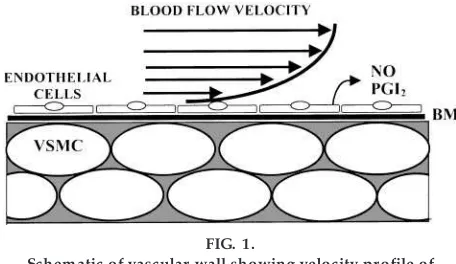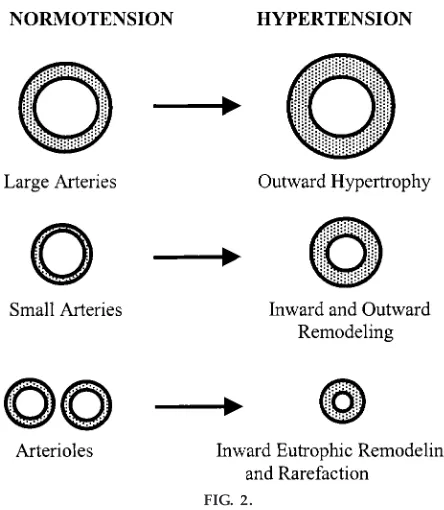TEACHING VASCULAR ADAPTATIONS
TO MECHANICAL STRESS
Russell L. Prewitt
Depa rtm ent of Physiologica l Sciences, Ea stern Virginia Medica l School, Norfolk , Virginia 23501
B
lood vessels change their number and structure in attempt to meet tissue demands for blood flow while simultaneously controlling mechanical stresses. A great deal of information is emerging in this field, especially concerning the role of the endothelium and signaling pathways for mechanotransduction. While not delving too deeply into the rapidly changing details, the students can be introduced to this exciting field by describing the structural changes that take place and outlining the major theories that are being investigated. The applications to peripheral vascular disease, myocardial infarctions, hypertension and tumor growth are readily apparent.AM. J. PHYSIOL. 277 (ADV. PHYSIOL. EDUC. 22): S211–S213, 1999.
Key words:arterial hypertrophy; capillary density; hypertension; mechanotransduction
Vascular adaptations consist primarily of changes in the structure and number of arteries and microvessels in response to changes in either blood pressure or flow. Changes in the structure of the arterial wall and lumen are also referred to as remodeling. Although these are not new observations, a great deal of information has recently emerged on the subject, and the mechanisms behind these adaptations remains a very active area for scientific investigation. As yet, the subject of vascular adaptations is not treated in most textbooks of medical physiology as a separate topic, but mention of it can be found with related topics, and it is not too early to introduce the students to basic concepts in this exciting area. At present we discuss these concepts in association with lectures on blood flow autoregulation, exercise, coronary blood flow, and hypertension. These are, of course, conditions under which mechanical stresses are changed in the cardiovascular system.
BACKGROUND
The integrative nature of physiology requires the understanding of several physical relationships and
regulatory systems to fully understand the mechano-transduction process leading to vascular adaptations. The groundwork for understanding pressure-induced adaptations is laid down in the hemodynamic lectures, in which the topics of parallel resistance, the Laplace equation, and calculation of wall stress are covered. The formula for calculation of parallel resistance (1/RT 5 1/R1 1 1/R2 1 ... 1/Rn, where RT is total
resistance andnis the number of parallel conduction channels for which resistance is calculated) makes it clear that the addition of parallel conduction channels results in a reduction of the total resistance through a vascular bed. The Laplace equation for circumferen-tial tension (T 5 rP, where T is tension, r is vessel radius, and P is distending pressure) shows that circumferential tension increases in an artery if blood pressure increases, but if the vessel constricts, as in a myogenic response, the tension can be controlled. Dividing by the thickness (w) of the wall will convert tension into circumferential wall stress (s 5 rP/w, where sis wall stress). This relationship shows why hypertrophy of the arterial wall can control wall stress during hypertension.
A P S R E F R E S H E R C O U R S E R E P O R T
1043 - 4046 / 99 – $5.00 – COPYRIGHTr1999 THEAMERICAN PHYSIOLOGICAL SOCIETY
Adaptations to changes in blood flow require the understanding of blood viscosity and shear stress. These topics are covered in most textbooks and should be part of the standard lecture material. As shown in Fig. 1, the velocity of laminar blood flow (V) increases from zero at the wall to a maximum in the center of the vessel. The concentric lamellae sliding past each other impart a force on the adjoining layer known as shear stress. Shear stress at the wall can be calculated as 4hV/r, wherehis viscosity. This stress is somehow sensed by the endothelial cells, and the students are told that this is the major question in this area of research at the present time. The suggestion that the mechanosensors may be shear-sensitive ion channels (6) or adhesion sites (3) is mentioned to give the students a feeling for the possibilities being explored in ongoing research.
VASCULAR DENSITY AND LUMEN SIZE
With this background, the topic of change in vascular density can be introduced in the lectures on regula-tion of blood flow as related to long-term autoregula-tion. It can be reinforced during lectures on coronary circulation and again while discussing the responses to chronic exercise. Decreases in blood flow, possibly caused by arteriosclerosis of a feeding artery or an acute myocardial infarction, lead to growth of eral arteries. The development of existent small collat-erals into larger ones depends on the shear stress sensed by the endothelial cells. Increased shear stress
triggers the release of the vasodilators nitric oxide (NO) and prostacyclin (PGI2) as shown in Fig. 1, but
how this leads to growth of the wall is still under investigation. Total flow to the tissue may at first be reduced after an occlusion, but flow and shear stress increase in the collateral vessels that run between a well-perfused area and the infarcted area. Hypoxic conditions also stimulate the growth of new vessels through the process of angiogenesis, whereby new capillaries sprout from existing vessels by migration of endothelial cells. Vascular endothelial growth factor (VEGF) is thought to be a mediator of this response, and inhibitors of the VEGF receptors show promise in preventing tumor growth (5). As the caliber of the lumen increases in the collateral arteries, shear stress is reduced toward normal (4hV/r) and blood flow to the distal bed is restored.
In chronic exercise, capillary density increases through angiogenesis in response to the increased demand for oxygen. The elevated blood flow in the feeding arteries causes an increase in shear stress that results first in vasodilatation and over time in a structural increase in lumen size. Increases in the caliber of the lumen are accompanied by thickening of the arterial wall, possibly in response to elevation in circumferen-tial wall stress as the lumen expands (Laplace relation-ship) (7), but, again, this point is unresolved. Chronic reduction in blood flow through an artery leads to structural reduction of the lumen, and this response is again dependent on the endothelium (4).
ARTERIAL WALL THICKNESS
Vascular adaptations are further developed as part of a lecture on hypertension. The most familiar adaptation to high arterial pressure is an increase in wall thick-ness of arteries upstream from the resistance vessels (Fig. 2). Fully exposed to the elevated pressure and increased circumferential wall stress, these vessels undergo a growth response characterized by hypertro-phy of vascular smooth muscle cells and accompany-ing extracellular matrix. This hypertrophy is in the outward direction with no reduction in lumen size. Because of the Laplace relationship, the students can see how the thickened wall is a mechanism to control circumferential wall stress in the face of continuing high arterial pressure.
FIG. 1.
Schematic of vascular wall showing velocity pr ofile of flowing blood and r elease of nitric ox ide (NO) and pr ostacyclin (PGI2) by endothelial cells in r esponse to
shear str ess. VSMC, vascular smooth muscle cells; BM, basement membrane.
A P S R E F R E S H E R C O U R S E R E P O R T
Downstream, the small arteries and arterioles reduce their lumen during the development of hypertension, at first by active tone, but over time the lumen is structurally reduced and tone returns toward control levels (2). In arterioles, lumen reduction is accom-plished without hypertrophy of the wall, but in small arteries, where tone is less and pressure higher, there is usually some accompanying hypertrophy. Again, the Laplace relationship shows that circumferential wall stress can be controlled by the combination of lumen reduction and wall hypertrophy. Although mechanotransduction of a pressure stimulus is still an unresolved topic, the response in a small artery appears to be correlated with circumferential wall stress rather than stretch of the vascular wall (1).
At the microcirculatory level, the number of capillar-ies and arterioles decreases in some vascular beds such as skeletal muscle, skin, and conjunctiva, a process known as microvascular rarefaction. The reduction in parallel conduction pathways results in a structural increase in peripheral vascular resistance. A number of factors contribute to the regulation of microvascular density, but a major hypothesis is that
rarefaction may be a method to autoregulate blood flow in the face of an elevated driving pressure. As such, it is the reverse of the increase in microvascular density that occurs with chronic exercise.
Although a great deal more information on the mecha-nisms of these adaptations is available in the literature, many are still hypotheses that need to be confirmed or refined. Although individuals working in this area may wish to provide greater detail on various aspects of these adaptations, we limit the topic to the introduc-tion as outlined above. Details on the mechanisms can be filled in as they become established in the future, while in the meantime the following general prin-ciples can be stressed. 1) Vascular adaptations are mechanisms to adapt the circulatory system to the needs of the tissues for blood flow while controlling mechanical stress.2) By sensing shear stress through an as yet unknown mechanism, the endothelium plays a critical role in adjusting the caliber of the arterial lumen. 3) Mechanical signals initiate the responses, and mechanotransduction pathways convert the sig-nal into a chemical and then a structural response.4) Mechanosensitivity is not limited to vascular cells but is a characteristic found in most cell types, and the signaling pathways may contain many shared elements.
Address for reprint requests and other correspondence: R. L. Prewitt, Dept. of Physiological Sciences, Rm. 2013, Lewis Hall, Eastern Virginia Medical School, 700 W. Olney Rd., Norfolk, VA 23507 (E-mail: [email protected]).
Refer ences
1. Allen, S. P., S. S. Wade, and R. L. Pr ewitt. Myogenic tone attenuates pressure-induced gene expression in isolated small arteries.Hypertension30: 203–208, 1997.
2. Hashimoto, H., R. L. Pr ewitt, and C. W. Efaw.Alterations in the microvasculature of one-kidney, one-clip hypertensive rats.
Am . J. Physiol. 253 (Hea rt Circ. Physiol. 22): H933–H940, 1987. 3. Ingber, D. E. Tensegrity: the architectural basis of cellular mechanotransduction.Annu. Rev. Physiol. 59: 575–599, 1997. 4. Langille, B. L., and F. O’Donnell. Reductions in arterial
diameter produced by chronic decreases in blood flow are endothelium dependent.Science231: 405–407, 1986.
5. Leenders, W. P. Targeting VEGF in angiogenic and anti-tumour therapy: where are we now?Int. J. Exp. Pa thol. 79: 339–346, 1998.
6. Olesen, S. P., D. E. Clapham, and P. F. Davies. Haemody-namic shear stress activates a K1current in vascular endothelial
cells.Na ture331: 168–170, 1988.
7. Tulis, D. A., and R. L. Pr ewitt.Medial and endothelial platelet-derived growth factor A chain expression is regulated by in vivo exposure to elevated flow.J. Va sc. Res. 35: 413–420, 1998.
FIG. 2.
Repr esentation of changes in lar ge and small artery cr oss sections during development of hypertension. Eutr ophic r emodeling means no change in wall cr oss-sectional ar ea.
A P S R E F R E S H E R C O U R S E R E P O R T

